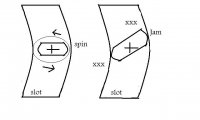CountryBumkin
Active Member
I installed toilet the other day with 5/16 brass flange bolts, and I noticed the flange bolts wanting to turn as I tightened the nuts. I marked the top of the flange bolt with a line showing direction of the "foot of bolt" so I could make sure the bolt did not turn so that it could come out of the slot in the flange.
It would have been easier if the flange bolt had a square shoulder just above the foot to keep it from rotating in the slot. Is there such a bolt? it seems likely that the bolt could turn enough to let it "pull through" the flange while tightening the nut.
Maybe if I had installed a nut on the flange to hold it place before setting the toilet this would not have been an issue.


This is flange type I have (PVC)
It would have been easier if the flange bolt had a square shoulder just above the foot to keep it from rotating in the slot. Is there such a bolt? it seems likely that the bolt could turn enough to let it "pull through" the flange while tightening the nut.
Maybe if I had installed a nut on the flange to hold it place before setting the toilet this would not have been an issue.
This is flange type I have (PVC)


